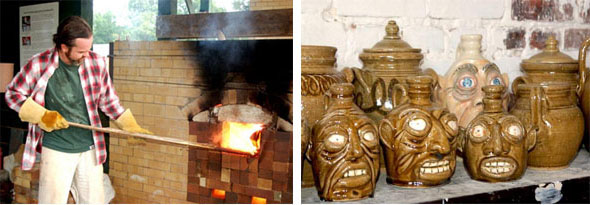Groundhog kilns: firing pottery the traditional way

This Aiken Standard article spotlights the groundhog kiln – a wood-burning furnace used by some potters in Aiken and Edgefield counties that are similar to the ones that were around in the 1800s. (Story and photos by DeDe Biles. View additional photos.)
Images: Left – master potter Justin Guy of Old Edgefield Pottery adds wood to the fire in the groundhog kiln owned by the Edgefield County Historical Society. Right – These face jugs and other pieces made by potter Gary Dexter were fired in the groundhog kiln at Gaston Livery Stable.
In an era when high-tech gadgets are all the rage, groundhog kilns remind us of the way things used to be.
The wood-burning furnaces used by some potters in Aiken and Edgefield counties today are similar to the ones that were around in the 1800s.
“It’s the traditional way of making pottery down here in the South,” said Gary Dexter, who built the groundhog kiln at Gaston Livery Stable, a historic barn on Richland Avenue, in 2012.
Dexter, who has been a potter for approximately 17 years, focuses on creating old-style, alkaline-glazed stoneware. He fashions pots, face jugs and other pieces from a mixture of two types of clay that he digs himself. Then he fires them in the Livery Stable’s groundhog kiln.
“It’s like a giant chimney that has been laid down on the ground,” Dexter said. “It’s about 7 feet wide by 14 feet long. There is a fire box on one end and a short chimney around 5 feet tall on the other.”
The kiln is made of refractory bricks that can withstand high temperatures. Dexter placed dirt and rocks along the sides of the kiln to hold it together.
“It’s kind of partially buried in the ground, and it looks like a groundhog’s burrow,” he said.
The kiln can hold 150 pieces of pottery. The clay they are made of hardens during the firing process, when the temperature inside the furnace rises to more than 2,000 degrees. Meanwhile, the glazes on the pottery melt and become shiny.
“I use pine wood, and the firing usually takes about 30 hours,” Dexter said. “Then it takes about four days for the kiln to cool down.”
Gaston Livery Stable is in the process of being restored, and the kiln “will be one of the anchors we are going to have here,” Dexter said. “As the restoration moves forward, we will have living history days when people will be making crafts and other things from back in the time when this barn was built, which was 1893.”
Dexter has a pottery studio at Gaston Livery Stable, and his apprentice, Siva Aiken, works there with him.
The Edgefield County Historical Society owns a groundhog kiln located near the intersection of U.S. 25 and S.C. 430. It is bigger than Gaston Livery Stable’s furnace.
“Ours is 22 feet long and about 8 feet wide in the middle,” said Master Potter Justin Guy of Old Edgefield Pottery. “We have 90 cubic feet to fill up, and we can put between 250 and 300 pots inside. But we’ve found that the kiln fires better if we put in fewer and strategically place the pots.”
The kiln has been operating since 2011.
“We built it in six to eight weeks,” Guy said. “It’s made of High-Fired Super Duty bricks (which have a temperature rating between 3,000 and 3,150 degrees).”

